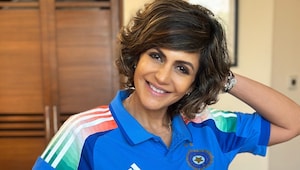
Get, set, go(ld): Sathiyan Gnanasekaran on putting India on the table tennis map
The sports star speaks to Cosmo India about learning from failure, playing table tennis, overcoming challenges, and more.

Nothing brings a country of 1.4 billion people together more than the love for sports. From the goosebumps-invoking chants of ‘India, India’ that echo across a stadium when we win to the radio silence in every corner of the country when we lose—sports has been a perennial part of passionate dinner table conversations and tea time tête-à-tête. Truth be told, we wouldn’t have it any other way.
In 2008, when ace shooter Abhinav Bindra became the first Indian to win a gold at the Beijing Olympics, the games sparked more than just a fleeting interest among sports enthusiasts and athletes alike.
What was once a country obsessed with cricket has witnessed quite a remarkable shift in the last two decades, with keen attention paid to the Olympic Games and the many sports that are part of it. In 2020, the Indian contingent consisted of 124 athletes, making it the largest the country ever sent to the Games. The athletes at the Games are those who know what it takes to be champions. They make sacrifices, take struggle in their strides, and exhibit an unwavering dedication to get to where they want to be. For them, giving up has never been an option—and it never will be.
As an audience, we are infinitely proud of who they are, all that they have achieved and everything they aspire to be. Cosmo India interacted with the athletes who are eager to see the Indian flag hoisted against the background of the national anthem, as they step onto the podium to receive a medal at the Paris Olympic Summer Games this year. These sportspersons let us in on how they build resilience in the face of inevitable hurdles, display perseverance beyond passion, and their incomparable feeling of being able to represent India.
Sathiyan Gnanasekaran is a prominent figure in Indian table tennis. From starting table tennis at five to representing India at the Olympics, he reflects on his relentless pursuit of excellence and the profound pride of seeing the Indian flag hoisted on the global stage. In conversation with Cosmo India, Gnanasekaran spoke about his journey from starting to play table tennis at five to representing India at the Olympics, his relentless pursuit of excellence, and more.
Sathiyan Gnanasekaran: Table Tennis player

Cosmopolitan India: What drew you to table tennis?
Sathiyan Gnanasekaran: Coming from a very academically driven family, I first started playing table tennis at the age of five, only because my mom wanted us to be active. It is such a fast-paced game, and I loved every bit. I started training every day. I played for India in 2005 as a 12-year-old. Then, the dream of playing for India at the Olympics came true in Tokyo (2020), and now again at the Paris Olympics this year.
C: What is your process of achieving peak performance during training?
SG: I always loved playing the sport, but winning is a big motivator as it pushes you. When you overdo it, that is when the stress kicks in. I keep small goals that I have to achieve each time—it could be a particular service or stroke. It can also be weekly goals for fitness, like hitting a few balls more than I did last week. Then, I try to emulate that in a match in a more systematic way. If I am able to do it twice in a match, that is also a win for me. The process is to divert my mind from winning or losing, and getting into the details of the game because I know if I achieve those smaller goals, a win is likely—maybe not today, but someday for sure.
C: Do you think passion is enough to keep you going?
SG: Passion is a key factor—without that, you can’t do anything. But you need to have a plan and training (schedule) in place irrespective of how you feel that day or how tired you are. I have days when I don’t want to get out of bed but if you give in to that, it becomes really difficult to be disciplined. Of course, your training is not supposed to be immensely difficult. You need to enjoy it; it has to be balanced. I break the monotony by incorporating small changes like doing Yoga or playing a game for fun. But ultimately, the single motivating factor is the love for the game. Even on days when I am on a break, I can’t sleep without playing a few shots. The sound of that (bouncing) ball gives me so much happiness.
C: What is the first thing you do instinctively after a win?
SG: I shout with joy—it is something that comes naturally to me. I like to express my feelings on the court, and I really love the adrenaline rush I get when I play the sport.
C: What is the best lesson that a failure has taught you?
SG: Failures teach you a lot more than wins because often, winning takes over your emotions. But that is when you ignore the small details or mistakes that you might have made during a game, or might make again. When you lose a match, of course, it is disappointing. However, it’s when you go deep into what has actually gone wrong, even if you have lost by a close margin. I rewatch my games, jot down my mistakes, and try to work on them during training. I like analysing. At the top level, everyone is bringing their A-game. So, it is about the small details and the mental aspect, not just the technical part.
C: What has been the most difficult challenge for you to overcome?
SG: There have been many since my engineering days. But just before the Rio Olympics (2016), my father passed away. That was a big setback. My mom was a rock-solid woman who supported us and took on the role of guiding us in the right direction. From there on, I started playing aggressively. That’s when I reached peak performance. The worst case? I’d lose a match, if any.
C: What is the best advice that you’ve received?
SG: For a long time, I had a very passive mindset. I did not want to take any risks. But my coach wanted me to be more aggressive and take initiative. I was taught to never miss a single ball. If someone plays 100 balls, I need to play 101. He always told me: ‘Make sure you play three balls and the fourth doesn’t come back’.
C: How do you deal with pre-game jitters?
SG: If you don’t feel anything before a match, it becomes hard to get that adrenaline rush. I feel butterflies in my stomach every single time—and I think it is necessary. I have learnt how to handle it better. I also work with a mental conditioning expert on how to refocus, practise focused meditation, and even visualisation techniques.
C: This is the first time the Indian table tennis contingent has secured a spot at the Olympics. Take us through that moment.
SG: At the World Championships (February 2024), we lost the second round against Poland. In the next round we were playing against Kazakhstan and we knew that if we won this match, we would qualify for the Olympics. It was a high-pressure game, and when we won, it actually took us some time to realise we had made it because we were in the zone. We were looking forward to this because it is the first time we have qualified for the main team event. It is a special feeling to be representing India. But qualifying is not just the goal...the job is only half done.
C: What has been your most significant moment of pride so far?
SG: It has to be the time when we won a medal at the Asian Games in 2018. Till then, India had never won an Asian Games medal in the team category, so winning that last point was a big moment that remains close to my heart even today. But, like I said, the top place is still empty. I want the national anthem to be played at the Olympics this year, because that is the best feeling any sportsperson can ask for. Winning the Olympic Games gold medal and the Indian national anthem playing on foreign soil—nothing equals that feeling.
Lead image credit: Mandeep Singh
This piece originally appeared in Cosmopolitan India, May-June 2024 print issue.
Also read: Is pickleball the new “it” sport in urban cities?
Also read: 10 Bollywood sports movies to watch when your motivation runs dry
more from Life

Mandira Bedi: “Young women can now play cricket without apology or hesitation”

Shafali Verma: “Everything starts with believing in yourself”

"Going phone-free for a week was harder than going sober for a year: 3 lessons I learnt the hard way"

Is 'bhajan clubbing' the coolest new way to party in India?

Ranking every Taylor Swift album, from debut to ‘The Tortured Poets Department’

What is ‘67’ and how it did it go from internet slang to word of the year?

‘Stranger Things’ changed pop culture forever—but can its final season pull off the perfect ending?

Horror movies are my favourite form of self-care and here's why it actually makes sense

Great “text chemistry” is the new love language of Gen Z dating—but almost no one’s fluent in it

How Zohran Mamdani won the NYC mayoral election by keeping it real
